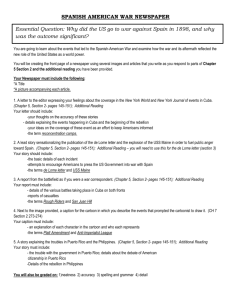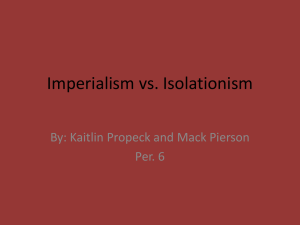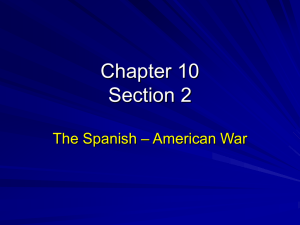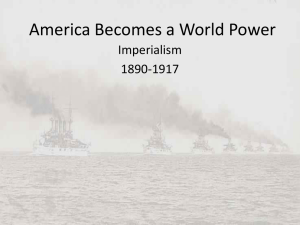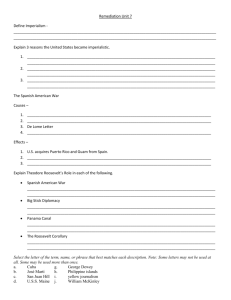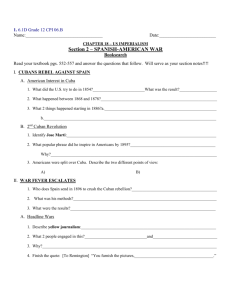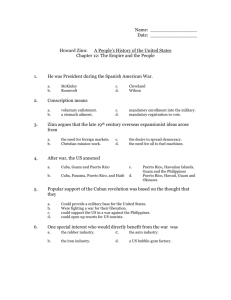Chapter 18: America Claims an Empire
advertisement
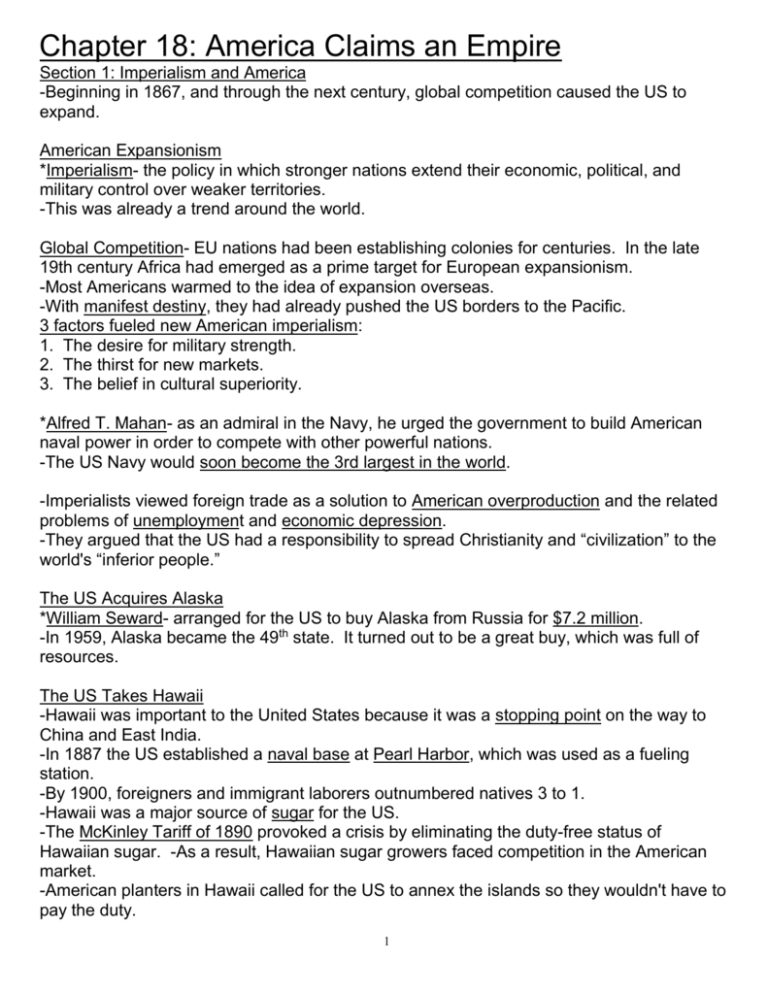
Chapter 18: America Claims an Empire Section 1: Imperialism and America -Beginning in 1867, and through the next century, global competition caused the US to expand. American Expansionism *Imperialism- the policy in which stronger nations extend their economic, political, and military control over weaker territories. -This was already a trend around the world. Global Competition- EU nations had been establishing colonies for centuries. In the late 19th century Africa had emerged as a prime target for European expansionism. -Most Americans warmed to the idea of expansion overseas. -With manifest destiny, they had already pushed the US borders to the Pacific. 3 factors fueled new American imperialism: 1. The desire for military strength. 2. The thirst for new markets. 3. The belief in cultural superiority. *Alfred T. Mahan- as an admiral in the Navy, he urged the government to build American naval power in order to compete with other powerful nations. -The US Navy would soon become the 3rd largest in the world. -Imperialists viewed foreign trade as a solution to American overproduction and the related problems of unemployment and economic depression. -They argued that the US had a responsibility to spread Christianity and “civilization” to the world's “inferior people.” The US Acquires Alaska *William Seward- arranged for the US to buy Alaska from Russia for $7.2 million. -In 1959, Alaska became the 49th state. It turned out to be a great buy, which was full of resources. The US Takes Hawaii -Hawaii was important to the United States because it was a stopping point on the way to China and East India. -In 1887 the US established a naval base at Pearl Harbor, which was used as a fueling station. -By 1900, foreigners and immigrant laborers outnumbered natives 3 to 1. -Hawaii was a major source of sugar for the US. -The McKinley Tariff of 1890 provoked a crisis by eliminating the duty-free status of Hawaiian sugar. -As a result, Hawaiian sugar growers faced competition in the American market. -American planters in Hawaii called for the US to annex the islands so they wouldn't have to pay the duty. 1 *Queen Liliuokalani- surrendered to the superior force of the US and the white foreigners who planned to overthrow her. -The US set up a government headed by *Sanford B. Dole. -In August 1898 Congress proclaimed Hawaii as an American territory. -In 1959 Hawaii became the 50th state. Section 2: The Spanish-American War -In 1898, the US went to war to help Cuba win its independence from Spain. Cubans Rebel against Spain -By the end of the 19th century, Spain- once the most powerful colonial nation on earth- had lost most of its colonies. -The US had long held an interest in Cuba, which lies only 90 miles south of Florida. (Sugar) -While President Pierce was in office he offered to buy Cuba from Spain. The Spanish responded by saying that they would rather see Cuba sink in the ocean. -When the Cubans rebelled against Spain, between 1868 in 1878, American sympathies went out to the Cuban people. The Second War for Independence -Anti-Spanish sentiment in Cuba soon erupted into a second war for independence. *José Marti- a Cuban poet and journalist in exile in New York launched a revolution in 1895. He organized Cuban resistance against Spain, using an active guerrilla campaign and deliberately destroying property, especially American owned sugar mills and plantations. This was all in an effort to get America involved in freeing Cuba. War Fever Escalates -In 1896, Spain responded to the Cuban revolt by sending *General Valeriano Weyler- to Cuba to restore order. *Yellow Journalism- exaggerates the news to lure and enrage readers. (William Randolph Hearst and Joseph Pulitzer) The De Lome Letter -In February 1898, the New York Journal published a private letter written by Enrique Dupuy De Lome, the Spanish minister to the United States. -A Cuban rebel had stolen the letter from a Havana post office and leaked it to the newspaper, which was thirsty for a scandal. -The letter criticized President McKinley, calling him “weak” and “a bidder for the admiration of the crowd.” -Americans were angry over the insult to their president. The USS Maine Explodes (Feb 1898) -A few days after the De Lome letter, an American ship blew up in the harbor of Havana. More than 260 men were killed. -President McKinley had ordered the USS Maine to Cuba to bring home American citizens in danger from the fighting, and to protect American property. 2 -At the time, no one really knew why the ship exploded; however, American newspapers claimed that the Spanish had blown up the ship. War with Spain Erupts -War cry "Remember the Maine!" -Public opinion favored war. April 20, 1898 the US declared war on Spain. The War in the Philippines *Commodore George Dewey- gave the command to open fire on the Spanish fleet at Manila, the Philippine capital. -Within hours, they had destroyed every Spanish ship there. Dewey's victory allowed US troops to land in the Philippines. -By August, Spanish troops in Manila surrendered to the US. War in the Caribbean -Hostilities began with a naval blockade of Cuba. -Dewey's victory in Manila had demonstrated the superiority of the US naval forces. -In contrast, the army maintained only a small professional force, supplied by a larger inexperienced and ill-prepared volunteer force. Rough Riders -A volunteer cavalry under the command of Leonard Wood and Theodore Roosevelt, who gave up his job as the Assistant Secretary of the Navy to lead the group. *San Juan Hill- the second victory for the US. Infantry attack. -US troops invaded Puerto Rico on July 25, 1898. *Treaty of Paris- on August 12,1898 the US and Spain signed armistice. The war lasted 16 weeks. -In December 1898, the US and Spain met in Paris to agree on a treaty. -Spain freed Cuba and the US gained the islands of Guam and Puerto Rico to the US. Spain also sold the US the Philippines for $20 million. -The US now had an empire. The next question Americans faced was how and when the US would add to its domain. Section 3: Acquiring New Land -In the early 1900s, the US engaged in conflicts in Puerto Rico, Cuba and the Philippines. -In 1916, the US made Puerto Ricans US citizens. Ruling Puerto Rico -Not all Puerto Ricans wanted independence. Some wanted statehood, while still others hope for some measure of local self-government as an American territory. -Puerto Rico was important to the US for maintaining a US presence in the Caribbean and for protecting a future canal in Panama. *Foraker Act- passed in 1900, this act ended military rule and set up a civil government in Puerto Rico. 3 -The act gave the president of the US the power to appoint Puerto Rico's governor and members of the upper house of this legislature. Cuba and the US -When the US declared war against Spain in 1898; it recognized Cuba's independence from Spain. *Teller Amendment- stated that the US had no intention of taking over any part of Cuba. -US aided Cuba -- food, clothes, schools, medical research, and sanitation. *Platt Amendment- a series of provisions that, in 1901, the US insisted Cuba add to its new constitution, commanding Cuba to stay out of debt and giving the US the right to intervene in the country and the right to buy or lease Cuban land for naval and fueling stations. -It remained in effect for 31 years. Cuba became a US *protectorate- a country whose affairs are partially controlled by a stronger nation. Protecting American Business Interests -The most important reasons for the US to remain in Cuba was to protect its investment in the islands sugar, tobacco, and mining industries, as well as railroads and public utilities. -The US would continue to try to control its Latin American neighbors. In the years to come, the US would intervene time and again in the affairs of other nations in the Western Hemisphere. Filipinos Rebel -The Filipinos were outraged at the Treaty of Paris. (Which called for the US to annex them) *Emilio Aguiraldo- was a rebel leader who believed that the US had promised them freedom. Philippine-American War -February 1899- the Filipinos, led by Aguiraldo, rose in revolt. -The US would use the same tactics in the Philippines that they had condemned Spain for using in Cuba. -About 200,000 would die. It took the US about three years to stop the rebellion. -The US set up a government similar to the one established in Puerto Rico. -The Philippines did not gain their independence until July 4, 1946. Foreign Influence in China -The US imperialists saw the Philippines as a gateway to the rest of Asia… especially China. -China was seen as a new potential market. -It also presented American investors with new opportunities for large-scale railroad construction. John Hayes Open-Door Notes -The US feared that China would be carved into colonies and that American traders would be shut out. -To protect American interests, US Secretary of State, *John Hay issued a series of policy statements called the *Open-Door Notes in 1899. 4 -These were letters addressed to the leaders of imperialist nations, proposing that the nation's share of their trading rights with the US, thus creating an open door. (No nation would have a monopoly) The Boxer Rebellion in China -A 1900 rebellion in which members of a Chinese secret society sought to free their country from Western influence, or as they call them “foreign devils.” -International forces put down the rebellion within two months. (GB, France, Germany and the US) -This rebellion led to a 2nd series of Open-Door Notes, announcing that the US would “safeguard for the world the principle of equal and impartial trade with all parts of the Chinese Empire.” -This paved the way for greater US influence in Asia. The Impact of US Territorial Gains -Under McKinley, the US had gained an empire. (Reelected in 1900). -Many anti-imperialists such as Carnegie, Jane Addams, Cleveland and Mark Twain all agreed that it was wrong for the US to rule other people without their consent. Section 4: America as a World Power -The Russo-Japanese War, the Panama Canal, and the Mexican Revolution added to America's military and economic power. Teddy Roosevelt and the New World -1901- McKinley is assassinated-Theodore Roosevelt becomes president. -1904- Czar Nicholas II (Russia) declared war on Japan- they were competing for control of Korea. -1905- Roosevelt mediated a settlement in the war between Russia and Japan. Japan took action first by a surprise attack on Russia. -1906- Roosevelt won the Nobel Peace Prize for negotiating the Treaty of Portsmouth. *Treaty of Portsmouth- in the settlement Japan wanted Sakhalin Island and a large sum of money from Russia. Russia refused. -Japan accepted half of the island and in exchange, Russia agreed to let Japan take over Russian interests in Manchuria and Korea. *Panama Canal- cutting across Central America to greatly reduce travel time between the Atlantic and the Pacific oceans. -In 1800, a French company had tried to build a canal in Panama. -After 10 years, the company gave up and sold its route to the US for $40 million. -1903- Panama declared its independence from Columbia. -The US and Panama signed a treaty stating that the US would agree to pay Panama $10 million plus the annual rent of $250,000 for the Canal zone. Constructing the Canal- ranks as one the world's greatest engineering feats. 5 -Work began in 1904 and by 1913, the climax of construction, more than 43,000 workers were employed. Over 5,000 died of accidents and disease. -The cost of the canal was about $380 million. -August 1914, the Canal opened for business. -US later compensated Columbia $25 million in 1921 for the country's lost territory. *The Roosevelt Corollary…to the Monroe Doctrine- (MD demanded that European countries stay out of the affairs of Latin American nations.) -Issued in 1904, the US claimed the right to protect its economic interests by means of military intervention in the affairs of the Western Hemisphere's nations. -“Speak softly and carry a big stick; you will go far.” *Dollar diplomacy- to exert influence over other countries. Woodrow Wilson's Missionary Diplomacy -According to Wilson, the US had a moral responsibility to deny recognition to any Latin American government it viewed as oppressive, undemocratic, or hostile to US interests. The Mexican Revolution -In 1911, Mexican peasants and workers led by Francisco Madero overthrew Porfirio Diaz. (Military dictator and US ally.) -After two years General Victoriano Huerta took over and executed Madero. -Wilson refused to recognize the government, calling it “a government of butchers.” Intervention in Mexico -April 1914- Huerta’s officers arrested and released a group of American sailors. -Wilson saw this as an excuse to intervene in Mexico. -Once the Huerta regime collapsed, a nationalist leader became president in 1915. Wilson withdrew the troops and formally recognized the new government. Rebellion in Mexico- many Mexicans did not support the new government. -Rebels under *Francisco “poncho” Villa and Emiliano Zapato would kill an American men in Mexico. -The US public demanded revenge. *General John J. Pershing- was ordered by Wilson to capture Villa dead or alive. -After a year of US troops looking for him. Mexicans grew angrier over the US invasion of their land. -In the end both sides backed down and Pershing was ordered to return home. -The US pursued and achieved several foreign policy goals in the early 20th century: 1. The US expanded its access to foreign markets in order to ensure the continued growth of the domestic economy. 2. The US built a modern navy to protect its interests abroad. 3. The US exercised its international police power to ensure dominance in Latin America. 6
